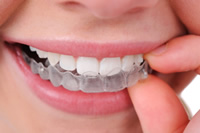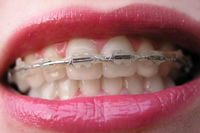Orthodontics
 Orthodontics is a dental specialty that focuses on the diagnosis, prevention, interception, and treatment of malocclusions of the teeth and surrounding structures. After graduating Dental School, an Orthodontist completes and additional 2-3 years of specialty training at an accredited Orthodontic Residency. Orthodontists straighten teeth by the use of bands, wires, braces, and other fixed or removable corrective appliances or retainers. Misaligned teeth are unattractive and can contribute to serious problems such as tooth decay and preventing the eruption of permanent teeth. Orthodontists straighten teeth by the use of bands, wires, braces, and other fixed or removable corrective appliances or retainers.
Orthodontics is a dental specialty that focuses on the diagnosis, prevention, interception, and treatment of malocclusions of the teeth and surrounding structures. After graduating Dental School, an Orthodontist completes and additional 2-3 years of specialty training at an accredited Orthodontic Residency. Orthodontists straighten teeth by the use of bands, wires, braces, and other fixed or removable corrective appliances or retainers. Misaligned teeth are unattractive and can contribute to serious problems such as tooth decay and preventing the eruption of permanent teeth. Orthodontists straighten teeth by the use of bands, wires, braces, and other fixed or removable corrective appliances or retainers.
Indications for Early Orthodontic Treatment
 The American Association of Orthodontists recommends that children by age 8 see and orthodontist to advise if orthodontic treatment is required and if it is the best time for the patient to be treated. The first permanent molars and incisors have usually come in by that time and crossbites, crowding, and other problems can be evaluated. When treatment is begun early, the orthodontist can guide the growth of the jaw and influence the eruption of incoming permanent teeth. Early treatment can also regulate the width of the upper and lower dental arches, gain space for permanent teeth, avoid the need for permanent tooth extractions, reduce likelihood of impacted permanent teeth, correct thumb-sucking, and eliminate abnormal swallowing or speech problems. In other words, early treatment can simplify later treatment.
The American Association of Orthodontists recommends that children by age 8 see and orthodontist to advise if orthodontic treatment is required and if it is the best time for the patient to be treated. The first permanent molars and incisors have usually come in by that time and crossbites, crowding, and other problems can be evaluated. When treatment is begun early, the orthodontist can guide the growth of the jaw and influence the eruption of incoming permanent teeth. Early treatment can also regulate the width of the upper and lower dental arches, gain space for permanent teeth, avoid the need for permanent tooth extractions, reduce likelihood of impacted permanent teeth, correct thumb-sucking, and eliminate abnormal swallowing or speech problems. In other words, early treatment can simplify later treatment.
If you notice any of the following warning signs of malocclusion in your child, it may be time to see an orthodontist:
- Protruding teeth
- Teeth that do not meet or meet in an irregular way
- Crowding or misplaced teeth
- Difficulty biting or chewing
- Difficulties with speech
Invisalign® Orthodontics
 Individuals who want to avoid the appearance of traditional metal braces often turn to Invisalign as a "virtually invisible" alternative. We use cutting-edge 3-D diagnostic imaging to map your mouth, design a specialized treatment plan, and create a series of custom-made aligners. You wear each aligner for approximately two weeks, progressing to each set until you reach the goal you agreed upon with your dentist.
Individuals who want to avoid the appearance of traditional metal braces often turn to Invisalign as a "virtually invisible" alternative. We use cutting-edge 3-D diagnostic imaging to map your mouth, design a specialized treatment plan, and create a series of custom-made aligners. You wear each aligner for approximately two weeks, progressing to each set until you reach the goal you agreed upon with your dentist.
The benefits of Invisalign include:
More attractive: Invisalign's clear, virtually-invisible aligners often go unnoticed.
More comfortable: Traditional metal braces may irritate cheeks and gums. Invisalign's smooth plastic aligners are more comfortable to many patients.
Eat the foods you want: Invisalign can be removed at mealtimes. Unlike traditional braces, you do not have to avoid the "problem foods," such as popcorn and apples.
Natural brushing and flossing: Because the aligners are removable, you can maintain good oral hygiene by continuing to brush and floss your teeth.
Invisalign vs. Conventional Orthodontics
Braces: Braces are a time-tested and effective means of aligning teeth. Brackets are attached, or "bonded," to the teeth and a wire is linked from bracket to bracket, applying gentle pressure. This pressure works to gradually shift the teeth into their proper position. Braces can be used to correct even the most severe cases of misaligned teeth.
Invisalign: For those looking to avoid the appearance of traditional braces, Invisalign is often the answer. A series of customized, virtually-invisible aligners-each of which is worn for a period of approximately two weeks-works to slowly shift your teeth into proper alignment. Many patients find Invisalign to be a more attractive and comfortable alternative to traditional braces.
Eliminating Impairment of Chewing Ability Caused by a Malocclusion
Malocclusion refers to any abnormal alignment of the teeth, including an overbite, underbite, crossbite or crooked teeth. These conditions involve problems with the fit of the upper and lower teeth. Misaligned teeth can lead to excessive stress that can gradually loosen or crack teeth.
For some patients, crooked teeth can cause difficulties with chewing and eating. Most cases of malocclusion can be corrected restoring full function to the teeth. Many cases can be treated by removing certain teeth making room for teeth still erupting, then attaching braces to the teeth to straighten the bite.
Correcting Temporomandibular Joint Abnormalities
A bad bite can be the cause of a disorder of the temporomandibular joint, also known as TMJ. The disorder is characterized by facial pain, headaches, earaches and clicking sounds in the jaw joint. The TMJ moves every time you talk, chew or swallow. It is one of the most frequently used joints in your body.
There are various treatments available for TMJ disorders, including wearing a mouth guard, therapeutic exercises and surgery. In some cases, orthodontic treatment can be beneficial in realigning the teeth to improve the patient's bite and help the jaw fit together properly.
Adult Orthodontics
 Orthodontic treatment is just not for children. While it is very beneficial to catch bite problems early because the bones are still growing, malocclusions can be successfully treated at any age. Crooked teeth, overbites, underbites, misaligned jaws and other dental issues can be corrected in adults in a little more time than children's orthodontics takes. Aside from achieving a beautiful smile you can wear proudly, orthodontics can provide you with a healthier mouth because straight teeth are much easier to clean, reducing your chances of developing tooth decay and gum disease.
Orthodontic treatment is just not for children. While it is very beneficial to catch bite problems early because the bones are still growing, malocclusions can be successfully treated at any age. Crooked teeth, overbites, underbites, misaligned jaws and other dental issues can be corrected in adults in a little more time than children's orthodontics takes. Aside from achieving a beautiful smile you can wear proudly, orthodontics can provide you with a healthier mouth because straight teeth are much easier to clean, reducing your chances of developing tooth decay and gum disease.
For more information about Cosmetic Dentistry or to schedule an appointment, feel free to fill out our convenient contact form or call us directly at 212-935-9300.

